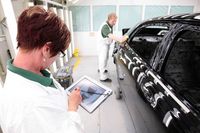The Bentley Mulsanne Story - Episode 2 - The Art of Colour - VIDEO ENHANCED
CREWE, England - March 9, 2010: Insight into the 86-hour process used to create the ‘unlimited palate’ available for Bentley’s new flagship
Exacting standards of craftsmanship and technology are employed by Bentley’s body assembly team to create the new Mulsanne’s distinctive, hand-crafted ‘hewn form solid’ appearance. But this is just a precursor to the painstaking attention to detail afforded to Bentley’s new 4-door flagship in the paint facility at the company’s headquarters in Crewe, England.
Click PLAY to watch video
The new Mulsanne will be offered in no fewer than 115 ‘standard colours’ and that is just the start of the story – because, like every grand Bentley – the only real limit on the colour of the car is the customer’s imagination.
Once the bare metal, pre-production Mulsanne bodyshell arrives at the paint shop via the automated overhead gantry, it passes through a series of full-immersion tanks, designed first to de-grease, then in turn to clean, condition, rinse, phosphate and passivate the steel and aluminium structure.
At each tank the shell is immersed before being tipped fore and aft to ensure that every single crevice is reached. Once drained, the bodyshell is lowered into an electro-coating tank, where power is increased to 320 volts, attracting particles-in-solution to deposit on the charged, metal bodywork to form, in conjunction with the phosphate, a hard protective shell of corrosion-proof zinc primer.
From this point, the judgement and skill of Bentley’s craftsmen come to the fore. A two-coat primer is applied by hand, ready for colour-of-choice to be applied. Each primed body is minutely inspected, sanded – or flatted – using a combination of hand and power tools. Only when the primer coat is flawless will the colour basecoat be applied, again by hand, to achieve the optimum finish. Clear lacquer coats are then applied robotically followed by final polishing for a perfectionist finish and detailed inspection in the specialist bays created for the Mulsanne.
But if the lacquer can be applied by robotics, why not the colour? Dave Walton of the Mulsanne bespoke paint shop explains:
“Different colours have markedly different characteristics and your perception of a colour’s shade changes according to how deep the coat is. Then there’s the fact that no two expert sprayers would apply that colour basecoat in exactly the same way. You learn to trust each craftsman’s eyes and skills, not just the process.
It takes many months of in-depth training for a quality control inspector to learn how to identify defects that an owner might never notice, yet each one will be rectified, even if this means sending it around the entire process again. We always operate way above customer expectations of quality,”
With the introduction of new satin paint finishes and two-tone colour schemes to Bentley’s extensive portfolio, Walton says the skills of the team are always evolving. Satin in particular can’t be locally reworked and polished, so even the most miniscule imperfection means the entire panel is refinished.
However, Bentley’s craftsmen are eagerly awaiting the moment the Mulsanne goes into full production according to Walton:
“We’ve been asked to match a paint finish to a cherished nail polish, a 50-year old classic Bentley and on one occasion a shade of turquoise on a food mixer for our Arnage, Brooklands and Azure customers. But even with over a hundred ‘standard colours’ to choose from we’re still looking forward to that first commission to create a bespoke colour from scratch and execute it perfectly.”
To watch the first pre-production Bentley Mulsanne’s take shape please log onto www.bentleymedia.com later this month.



